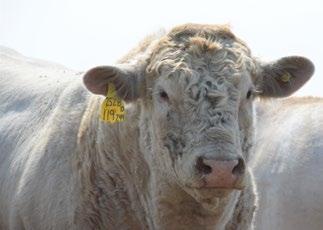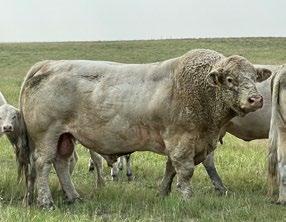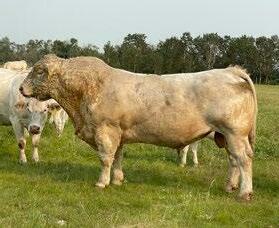
3 minute read
The No Nonsense PROGRAM
Rawes Ranches was established near Strome, Alberta in the mid-forties by Herman and Elaine Rawe. In the early fifties, the cattle industry moved toward more feeding of cattle for the slaughter market, and our family responded with an expansion of our commercial Hereford-based cow herd. That is where our focus began; to raise cattle that excel in the auction barn, the feedlot, and at the meat counter.
Always looking for a better way to do things, Herman started using Charolais bulls in 1957 and was a founding member of the Canadian Charolais Association. From the beginning, our feedlot involvement and fat cattle marketing, alongside building a registered Charolais cow herd, kept our ideas in focus. This naturally led to a “No Nonsense” Program founded on COMMON SENSE, CONSISTENCY, AND PROFITABILITY. Today, this focus remains the same. Simply put, the cattle must meet the needs of the marketplace they were designed for. Rawe Ranch cattle are produced and sold with honesty and integrity. We don’t have banners, ribbons, or trophies; we have a long-standing program, satisfied customers, and functional cattle that excel in all areas of production having been proven in the industry.
All sale bulls are ONE IRON, bred and raised on the ranch. We have personally attended to our Charolais breeding and herd management for FIFTY-ONE YEARS. The purebred herd was established in 1972 and today undergoes annual evaluation and replacement by our own females sired by our own ranch-raised bulls without the possibility of setbacks from outside genetics. In doing so we have CONCENTRATED OUR GENETICS in the areas we feel are most important: feet and longevity, temperament, performance, and carcass quality.
The cows CALVE ON PASTURE during May and June. Today, 23% of our breeding herd are 8 years and older, 61% are between 3 and 7 years, and 16% are first-calvers. The consistency in our program is proven by these older productive cows that have not been pampered, never had their feet trimmed, and calved unassisted every year. There is no distinction in management practices between our purebred and commercial cow herds.
A large herd and RIGID CULLING PROGRAM ensure that only the top end of our productive animals continue in the program leading to steady advancement year over year. We don’t sell replacement females or proven cows from the herd. They either work for us, or they don’t work at all, they’re functional or they go! Yearling heifers not selected for breeding and bulls not selected for sale are finished for harvest under our feeding and management. Each year we obtain performance and grading information to EVALUATE AND IMPROVE our genetics. We have always strived for growthy cattle; however, we realized very early on that performance achieved through growth alone (high frame score) was not sustainable. For growth to have any value it must be combined with rapid fleshability and the PRODUCTION OF RED MEAT. This understanding is the foundation of our program and has developed a genetic package with proven performance in all stages of the production cycle. Our bulls are raised under the same principles as the cow herd. They are May-June born, calved on pasture, weaned in November, and undergo a full 15 months of evaluation to sell between 18-20 months of age after they have MATURED AND ARE READY TO GO TO WORK. They aren’t pushed to sell as yearlings. All bulls are developed for our annual bull sale; we don’t sell by private treaty nor consign to other sales. We believe in letting our cattle sell in the COMPETITIVE MARKET and letting you, the commercial cattleman, be the judge.



Rawes Ranches has maintained a focus on Performance Testing throughout our time in the cattle business. In 1990, our sale was the first in Canada to print EPDs in a sale catalogue. The addition of carcass data came in 2000 and has since been displayed as an EPD value.



And it all starts at calving time when data is first collected on the animal. Our second-calvers and mature cow herd calve on grass in May through June. We like to calve cows on carry over grass (barring a drought). The cows are moderate framed “Charolais” cows. After coming through the winter and into calving season, they are in their working clothes; not carrying a lot of extra flesh and weighing roughly 1500-1600 pounds. It’s the norm for these cows to have calves weighing 100-110 pounds. A lot of that weight is in extra length. We are not ashamed to print what the scale reads. We believe the shape of the calf is, for the most part, more important than the weight of the calf. Rarely do we ever bring a cow in unless it’s for malpresentation. Like most operations today, we simply don’t have time for unnecessary problems.




